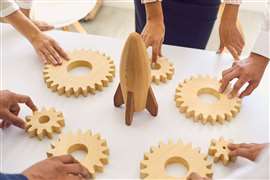Controlling safety in the lifting industry
07 May 2013

Throughout the radio remote control industry, safety is more than just a requirement. As manufacturer Ikusi’s philosophy states, safety is an unavoidable necessity.
The most up to date safety standards in radio remote control (RRC) systems is ISO 13849-1. The new safety standard replaces EN 954-1 and uses the performance level as a measure of the reliability of a safety function.
“For the new safety standard, five performance levels are established, from ‘a’ to ‘e’, where ‘a’ is low danger and ‘e’ is high danger,” says Mónica Lorenzo, Ikusi R&D department remote control units. “This standard is applied to each of the safety functions on the machine, such as energy dissipation and isolation function and the emergency stop function.
“The remote control is part of the complete system that performs the emergency stop safety function,” Lorenzo adds, “therefore, when calculating the machine’s performance level for this safety function we must take into account the performance level of the remote control’s emergency stop.”
A spokesperson from remote control manufacturer Autec, explains the point further, “This translates in specific design choices as hardware redundancy and diversity, diagnostics of dangerous failure, choice of components with high reliability, rigorous software development and painstaking tests. Redundancy, diversity, high reliability components, diagnostic measures, extensive tests: all of these measures add up to offer to the user higher safety and reliability of safe RRCs, thus reducing risks of hazards and the probability of litigation.”
In response to the new standards, remote control manufacturers are developing updated products and models to meet the new requirements. In line with its safety philosophy, Ikusi is in the process of developing the performance level of the stop function in all of its remote controls. It is developing the process with a leading German laboratory in this field (BGIA or the German Institute for Occupational Safety).
“With this certification Ikusi will maintain its commitment to ensure its remote controls comply with the highest safety standards and regulations of the multiple geographical areas in which it works, which allows it to operate in the most demanding environments and conditions,” a company spokesperson says.
Autec is also taking into account the new safety standards and has included the mandatory stop function in its remote controls. “In some cases the UMFS (unintended movement from standstill) function may also be required,” a spokesperson adds. Autec’s Dynamic series has been certified for functional safety by TÜV Süd, a technical service corporation. The Dynamic series includes the stop safety function, which complies with requirements of EN ISO 13849-1 Performance Level “e”, Cat. 4 and EN IEC 62061 Safety Integrity Level 3. The UMFS safety function provides PL “d”, Cat. 3 / SIL2.
In other areas of safety, Autec has also developed a basket and observer system, which is a solution for elevated work platform control near live overhead power lines. “This system ensures operators can safely operate. The ‘basket’ transmitter is used to control the machine during normal operations, and the ‘observer’ transmitter can intervene and take control in case of an emergency. Three-axis joysticks have also been implemented in the Autec Dynamic series, providing single-handed multi-axis control,” the company adds.
Manufacturer Åkerströms has also developed a line of products which meet the safety regulation EN 13849-1. “The latest safety technology that our remote controls meet is EN 13849-1 Cat 3 performance level d for safety stop function. Safety relays enable approved movements according to EN 13849-1 Cat 3, performance level d,” An Åkerströms spokesperson said.
New models from Åkerströms will be launched at the Hannover Messe technology show. “We are launching several new models this year, including both joystick and pushbutton transmitter models. The models include robust and ergonomic designs, new improved radio modules with new frequency ranges and large readable LCD displays with self-healing scratch shields,” a spokesperson adds.
At the receiving end, receivers from manufacturer HBC-radiomatic meet safety requirements in several ways. The receivers are in a plastic housing to protection class IP 65 and have an E-Stop circuit. HBC-radiomatic has released two new plug and play receivers, the FSE 308 and the FSE 312 for the wireless control of chain hoists and standard industrial cranes.
The FSE 308 has eight relay outputs for the black and white control commands for the wireless control of standard chain hoists. The FSE 312 has four additional relays, which allows for the control of standard industrial cranes. Both have a Han 10 plug connection. The FSE 308 is 119 x 141 x 57 mm and weighs 550 grams. The FSE 312 measures 150 x 141 x 64 mm and weighs 680 grammes.
Wireless
With a range of new products entering the market with the updated safety regulations, the battle for ongoing air space becomes even more intense. This issue is another area that manufacturers are striving to overcome.
To meet this demand, Magnetek, a manufacturer of digital power and motion control systems, introduced its new range of CAN-2 receiver. It makes it possible to add a wireless control to any CAN-bus controlled machinery, the company says. To meet safety standards, the CAN-2 has two redundant machine stop outputs. It also has two CAN-bus ports and offers the choice of 400 MHz, 900 MHz, or 2.4 GHz RF channels.
“The CAN-2 is a flexible receiver option that can be easily integrated into CAN-based products or products with any CAN-based protocol including J1939, CANOpen, ICP and others,” said Eugene Novak, Magnetek radio controls product manager. “The small compact design is rugged enough to handle outdoor environments, and the quick response allows for precise control, without the latency found in other radio control systems.”
Efficiency and range is another area in the remote control market that is an important issue. Issues such as these tend to be implemented into the design of remote controls, as Åkerströms explains, “We offer adapted radio modules for different applications and for issues such as the ongoing battle for air space we have a wide range of frequencies.”
For other companies, meeting these concerns has been included in the controls’ designs for some years. “Our products have been implementing automatic and dynamic spectrum-access techniques for some years now, thus significantly improving the radio performances,” an Autec spokesperson says.
As an example, the Autec FJR transmitter, includes a control system that constantly scans the frequency band and automatically ‘moves’ to a free frequency. A frequency management system is also incorporated in HBC’s FSE 308 and FSE 312. “Both products come with a frequency management system enabling the receivers to work without conflicting with other frequencies,” a company spokesperson said.




